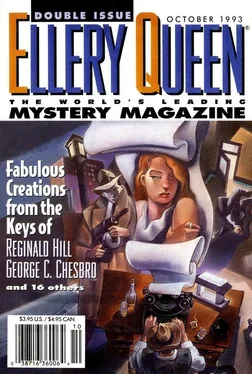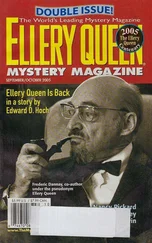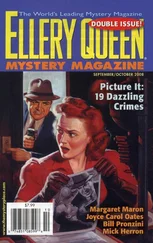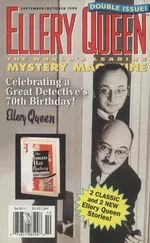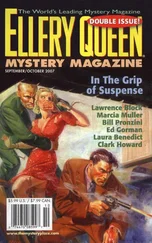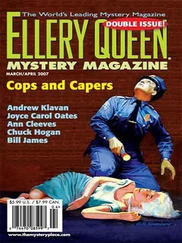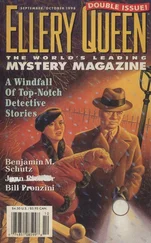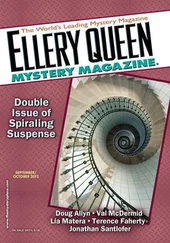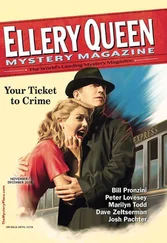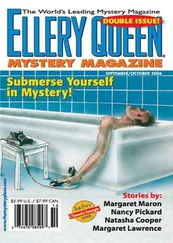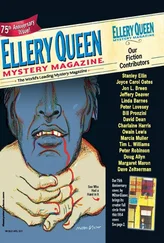Charles Ardai - Ellery Queen’s Mystery Magazine. Vol. 102, No. 4 & 5. Whole No. 618 & 619, October 1993
Здесь есть возможность читать онлайн «Charles Ardai - Ellery Queen’s Mystery Magazine. Vol. 102, No. 4 & 5. Whole No. 618 & 619, October 1993» весь текст электронной книги совершенно бесплатно (целиком полную версию без сокращений). В некоторых случаях можно слушать аудио, скачать через торрент в формате fb2 и присутствует краткое содержание. Город: New York, Год выпуска: 1993, Издательство: Davis Publications, Жанр: Детектив, на английском языке. Описание произведения, (предисловие) а так же отзывы посетителей доступны на портале библиотеки ЛибКат.
- Название:Ellery Queen’s Mystery Magazine. Vol. 102, No. 4 & 5. Whole No. 618 & 619, October 1993
- Автор:
- Издательство:Davis Publications
- Жанр:
- Год:1993
- Город:New York
- ISBN:нет данных
- Рейтинг книги:3 / 5. Голосов: 1
-
Избранное:Добавить в избранное
- Отзывы:
-
Ваша оценка:
- 60
- 1
- 2
- 3
- 4
- 5
Ellery Queen’s Mystery Magazine. Vol. 102, No. 4 & 5. Whole No. 618 & 619, October 1993: краткое содержание, описание и аннотация
Предлагаем к чтению аннотацию, описание, краткое содержание или предисловие (зависит от того, что написал сам автор книги «Ellery Queen’s Mystery Magazine. Vol. 102, No. 4 & 5. Whole No. 618 & 619, October 1993»). Если вы не нашли необходимую информацию о книге — напишите в комментариях, мы постараемся отыскать её.
Ellery Queen’s Mystery Magazine. Vol. 102, No. 4 & 5. Whole No. 618 & 619, October 1993 — читать онлайн бесплатно полную книгу (весь текст) целиком
Ниже представлен текст книги, разбитый по страницам. Система сохранения места последней прочитанной страницы, позволяет с удобством читать онлайн бесплатно книгу «Ellery Queen’s Mystery Magazine. Vol. 102, No. 4 & 5. Whole No. 618 & 619, October 1993», без необходимости каждый раз заново искать на чём Вы остановились. Поставьте закладку, и сможете в любой момент перейти на страницу, на которой закончили чтение.
Интервал:
Закладка:
I had no reason to hang back. If I sang his praises then, I might later have the golden opportunity to say that I “discovered” Leifcrown.
And I did.
Not that the market accepted him as a new Rodin overnight. But after Henry Moreland agreed to put Leifcrown’s work on display, things developed. Gradually he began to have more exhibits, sales, and assignments. He rose steadily and didn’t stop until the night he gave in to a craving for rat poison.
His talent was there all along, developing. What had really changed was his approach, his themes, his feelings.
The world was falling down around us then. It still is, and maybe has irrevocably collapsed. But those days were the scariest in a long, long time. All of a sudden the nice kids that were to be the beneficiaries of the civil rights struggle could be found on street corners peddling all sorts of new and dangerous drugs. The dream had become a pipe in every mouth and a .38 midnight special in every pocket. People began dying without any reason, and serial killing seemed to be the rage, with bodies that never reappeared and murderers who smiled too much on camera. Nice couples who had met in college and gotten married after getting jobs and cars were now out on the street along with their dreams and children, fighting for a better cardboard box in which to sleep and sob. Spiritual leaders were carted away to jail for fraud and rape. Businessmen were their next-cell neighbors, along with the ever-present politicians.
All of that could be found on the faces and figures Leifcrown sculpted. Especially the bronzes. Every cruel metaphor of society was imbedded in the pieces he began to turn out. But that was not all: it wouldn’t have been enough to turn him into the artistic demigod he became. There was also the tenderness, the gentle caring that spelled hope amidst the horror. That was what drew you to his figures. Yes, they were often wretched, but never despairing. Victory might have been tom away from their grasp, but not glory. He distilled the horrors of the time and then drew magnificent conclusions that appeared to be rooted in all the good that humanity was capable of. Greatness coming from ruin, promises being born from pain and confusion. His sculptures had a soul, we all knew, but we didn’t say it because it sounded corny and trite.
I wrote that if it is the artist’s ultimate goal to draw order from chaos, then the world today was perfect raw material for any artist, since chaos had almost eaten up everything that really mattered. And I added that no artist could find such perfect order as Leifcrown had.
Even though I regularly published pieces like that one, in which I hailed him as a genius, and went on writing about every major exhibit and every turn his career took, surely helping to assure his success, we never became friends. Leifcrown had no friends.
He wasn’t rude or ill-tempered, and he didn’t actively drive people away; he was kind and tolerant. He just didn’t seem to have time for his fellow humans. He seemed uncomfortable — not angry, just out of place around other people. So when they came around, they soon felt like intruders and left Leifcrown alone with his clay and plaster and metal.
In that respect I was the closest to him. I enjoyed access to his studio, where I saw his sketches and projects, and tried my best to make good use of the favor, careful never to overdraw the account of privileges allotted me by good luck and a moment of boldness.
I saw that Leifcrown worked in creative attacks, completely devoid of discipline. He could spend weeks without drawing or modeling. Then something would happen and he would go into a frenzy, turning out incredible quantities of work, sculpting several pieces at a time, an armature here, an already cast figure ready for patina to be applied there, a plaster cast way over there, and three or four clay models lying around. In a few weeks, all the pieces would be ready for shipment, exhibition, or sale, and Leifcrown would slip back into his artistic inactivity.
I could say now that there was a pattern to his work, but it’s maybe only hindsight. When something big happened, it was like a spark that would jump-start his creative process. A gang war in the inner city. A scandalous murder. A large layoff of workers. Big, juicy scandals involving the rich and powerful of the land. The beginning of a new armed conflict somewhere around the world. Any tragedy. Looking back, it seems that he thrived on those events, used them to fuel his sculpting. At least most of the time.
The critics finally raved in a manner reserved only for great long-dead artists like Van Gogh. Leifcrown was on his way to becoming a latter-day Picasso, admired and revered, absolutely successful while still alive and able to enjoy it. He evolved and diversified, creating human figures, mythological creatures, abstract shapes, a strange series of eight sculptures for the blind which were not supposed to be seen by the public, but touched through a dark screen with holes for your hands. And we all talked about the powerful kindness present in every piece, competing for adjectives.
Leifcrown fascinated not only art critics, but the world at large. Art-school teachers talked about his sculptures in class. His generous contributions to charities touched the imaginations of people who never went to art exhibits. His “Broken Hands” bronze, which he donated for the entrance to the Red Cross building in Geneva, found its way into all the newspapers when it was unveiled.
More than a sculptor, Leifcrown was fast becoming a pop hero: an event, a cult personality, even though he shunned publicity and hardly ever went to social events. That made him all the more interesting.
Then it happened. I was with him.
It was back in Henry Moreland’s gallery, where a grand exhibit celebrating Leifcrown’s fiftieth birthday was being prepared. Leifcrown was always there when his sculptures were moved around. He was overprotective of them. He orchestrated the movements of the strong men who loaded and unloaded, crated and uncrated his art.
Somehow, someone forgot that one of the exhibition rooms was split-leveled. While Leifcrown was talking with Moreland, a mover carted one of the sculptures right through. It bounced on the two steps, fell off the gurney, and crashed to the floor with a sound that rolled through the whole building. And later through the whole country.
We ran to the room. Nothing serious seemed to have happened. Bronze is tough. It was one of those abstract figures that always seemed to be something and was nothing, and there was just a tiny hairline crack running along one side of it, but Leifcrown blew like a landmine. He threw himself against one of the burly men carrying the sculptures until the man gingerly pushed him away and Moreland intervened. I tried to talk with Leifcrown, but he left hurriedly.
He never came back. That night he died, and he was found the next morning by the cleaning woman who took care of his apartment. There was no suicide note, but the circumstances were evident, and many concluded that his inordinate love for his sculptures had detonated all the little problems that had been slowly building inside him. Seeing one of them broken had made him go over the edge.
That was when we all wrote the eulogies that sang his praises to the world. Long-winded pieces, careful analyses, academic considerations, and loving articles. As he lay in state, as he was buried, as the decision was made to open the exhibit as a posthumous homage to Leifcrown, newspapers and magazines ran thousands, maybe millions of words about the late sculptor.
The exhibit opened in a gloomy atmosphere. When I arrived, the whispering that had taken the place of the loud conversation usually found at openings subsided even more. Many of those present knew that Leifcrown and I were close.
Читать дальшеИнтервал:
Закладка:
Похожие книги на «Ellery Queen’s Mystery Magazine. Vol. 102, No. 4 & 5. Whole No. 618 & 619, October 1993»
Представляем Вашему вниманию похожие книги на «Ellery Queen’s Mystery Magazine. Vol. 102, No. 4 & 5. Whole No. 618 & 619, October 1993» списком для выбора. Мы отобрали схожую по названию и смыслу литературу в надежде предоставить читателям больше вариантов отыскать новые, интересные, ещё непрочитанные произведения.
Обсуждение, отзывы о книге «Ellery Queen’s Mystery Magazine. Vol. 102, No. 4 & 5. Whole No. 618 & 619, October 1993» и просто собственные мнения читателей. Оставьте ваши комментарии, напишите, что Вы думаете о произведении, его смысле или главных героях. Укажите что конкретно понравилось, а что нет, и почему Вы так считаете.
